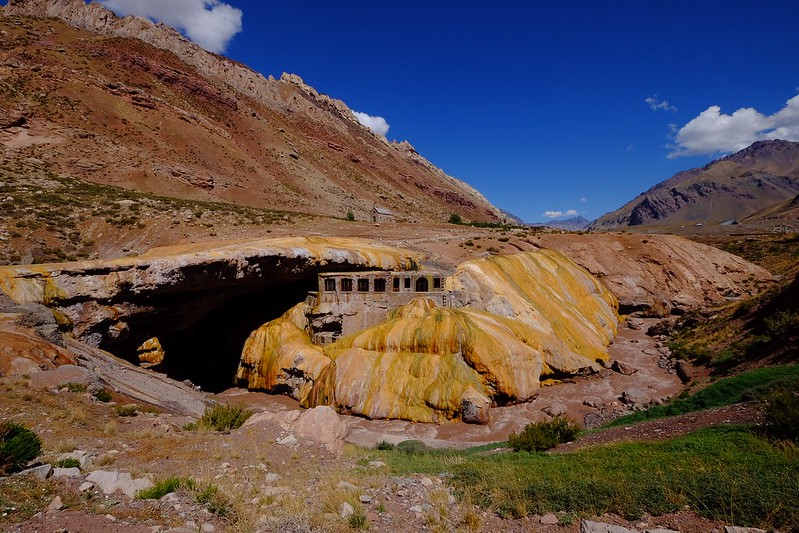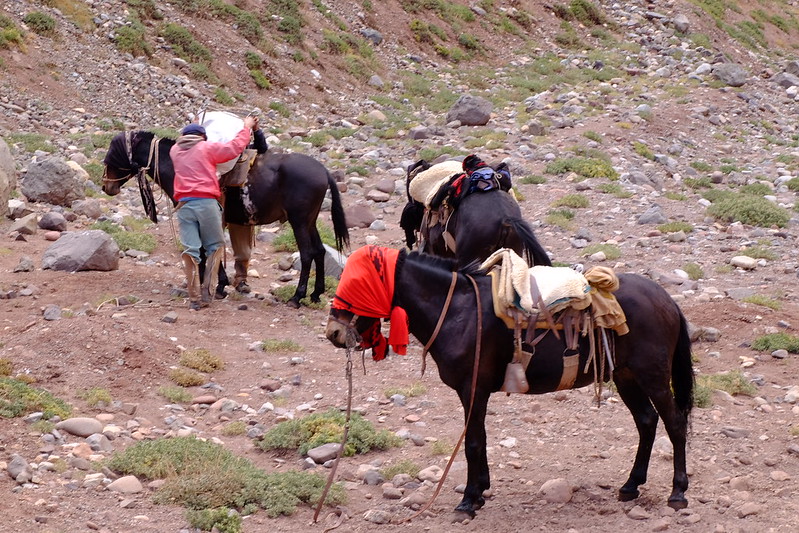To get from Valparaiso to Mendoza, our last stop in Argentina, one must cross the Andes and the Chile/Argentina border. Again.
 Looking west into Chile at the road we just came up on the bus.
Looking west into Chile at the road we just came up on the bus.
As an aside, I just counted and each of us has 9 stamps from Argentina and 7 from Chile in our passport due to our zigzag trip, and we should have 10 and 8 but between Chile and Mendoza they don’t give you an exit stamp for some reason. Glad we both got new passports for this trip! But back to the point. We’ve opted to take the bus for journeys like this because we don’t think one can ever cross the Andes by road too many times. Once again, the drive was stunning and made the 3 hour wait at the border — each way — worth it.
This crossing took us through mostly desert landscapes with kaleidoscopic rock colors. It was like Death Valley and southern Utah all in one, accented by a few distant snowy peaks. It’s impossible to capture the grand scale of the landscape here, which we first experienced on our bus ride from Chile. These mountains are just plain huge, and go on and on and on.
We arrived in Mendoza on, once again, a Sunday evening when most restaurants are closed. We have developed a real knack for arriving in new places on Sundays when everything is closed. Thankfully Mendoza is a big enough city that we found a delicious Peruvian restaurant open.
We rented a car and used Mendoza as a base to explore the area for a few days. Mendoza sits in a desert, and for decades has been irrigating its crops with runoff from Andes snowpack that is distributed through irrigation channels throughout the valley. There must be a ton of snowpack because the crops are extensive.
We learned that grapes are not the only thing grown in the area; olives are too, and several olive farms give tours and tastings. We took a really interesting tour of an olive farm and learned how and when olives are picked, how they are preserved and olive oils made, and got to taste some truly fabulous olives and oils. In fact, we ate an entire jar of one variety of their olives the next day in the car.
 Looking west into Chile at the road we just came up on the bus.
Looking west into Chile at the road we just came up on the bus.
 Large vats where olives are initially stored in brine.
Large vats where olives are initially stored in brine.
Then there were the grapes, growing as far as the eye could see. Malbec definitely reigns here, but there are a few other varietals that are also grown well. We went to the Uco Valley, a beautiful valley that seems to be home to the highest quality wines.
We took a tour through The Vines of Mendoza, which is incidentally the company that offered me a job in 2012 and basically sparked the idea for this trip. Anyway, they have an interesting business model in that they contract with people all over the world who want to have their own Argentinian vineyard and wines. The Vines will grow and pick the grapes you want, then make, bottle and label the wine with your own label and ship it to you and/or sell it at their winery. Based on our wine tasting, they definitely know what they are doing, so if you are in the market, you should check them out : )
 Salentein Bodega in the Uco Valley, which had great wines too. Note the Andes in the distance.
Salentein Bodega in the Uco Valley, which had great wines too. Note the Andes in the distance.
 Aconcagua has some hanging glaciers that are 1,000 feet thick.
Aconcagua has some hanging glaciers that are 1,000 feet thick.
Our hike started at 9,200 feet, and climbed a bit but not too much since we only had the day — if we were to do this again, we would have allocated more time here to acclimatize and do a three-day hike to the first two climbers’ base camps. Regardless, the hike was beautiful.
On our hike, we got to see three mule trains coming down from the mountain, at an extremely fast trot I might add. The mules are used to carry the climbers’ gear and food.
And with that, we left Argentina for what should be the last time on this trip, only to head to Santiago for one night before leaving Chile for what should be the last time as well. Will we miss the legendary Argentinian steaks? In a word, no. For one thing we’re not big steak eaters, but more importantly they export their best beef, so we were not overly impressed by the steak down here. What we will miss is Argentina’s tasty eggs with proper dark orange yolks, grocery store orange juice that tastes fresh-squeezed, hauntingly fantastic chorizo sausages, skeleton keys, rickety old-fashioned elevators with slide gates and doors, and amazing scenery. We’ll miss Chile’s huge variety of great quality vegetables and fruits, empanadas (especially the chicken ones), wine, good roads and, again, amazing scenery.





















8 replies